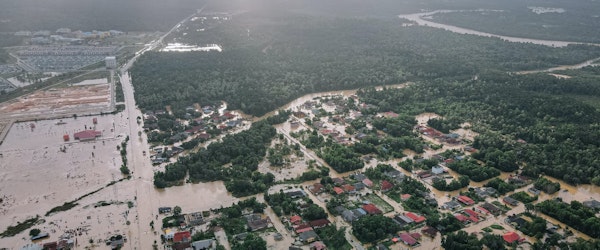
Global Flood Risk Study Highlights Population Growth in Flood-Prone Areas
Monday, October 7th, 2024 Catastrophe Legislation & Regulation Property Risk ManagementFlooding is one of the most pervasive and recurrent natural disasters worldwide, with devastating effects on human communities and the environment. Over the past several decades, the frequency and intensity of flooding have increased significantly, driven by climate change, rapid urbanization, and changing land-use patterns. A recent comprehensive study analyzes population exposure to both inland and coastal flooding, offering crucial insights into how flood risk has evolved over the last 40 years and how it is projected to change in the future.
The study reveals that approximately 2.7 billion people—more than one-third of the global population—currently reside in areas at risk of significant flooding during a 100-year return period. Of this total, 2.4 billion are exposed to inland flooding caused by river overflow and extreme rainfall (fluvial and pluvial flooding), while 260 million face the threat of coastal flooding driven by storm surges and tidal activity. The research shows that 29% of the global population is exposed to flood depths of more than 10 centimeters, with those numbers expected to grow as population increases in flood-prone areas.
Inland flooding presents the greatest risk, affecting 31% of the population, with South Asia standing out as the most vulnerable region, where nearly 40% of residents face inland flood risks. Coastal flooding, though affecting a smaller proportion of the population globally (around 3%), is concentrated in a few key regions, with over 70% of those exposed living in just five countries: Bangladesh, China, India, Vietnam, and the Philippines.
The study combines global population data from the European Commission’s Joint Research Center with advanced flood hazard data from Moody’s RMS Global Flood Data and Maps, which assesses flood risk at varying return periods ranging from 10 years to 1,000 years. For instance, the analysis shows that at a 100-year return period, the population at risk of inland flooding could increase to over 4 billion people globally by 2030, particularly in regions with rapid population growth and insufficient flood defenses.
One of the critical aspects of the study is its evaluation of the role of flood defenses. While flood defenses—such as levees, embankments, and drainage systems—provide protection for a significant portion of the population, they are not uniformly effective across regions. In well-defended areas like Europe and North America, up to 46% of those at risk from inland flooding are protected from high-severity events. In contrast, in regions like Africa and South Asia, fewer than 10% of the population benefits from comparable defenses, leaving large segments of the population highly vulnerable.
The analysis also highlights the growing disparity between population growth and the availability of flood defenses. In many areas, population growth in flood-prone regions is outpacing the development of protective infrastructure. This is especially concerning in low- and middle-income countries, where economic constraints and political challenges hinder the implementation of effective flood mitigation strategies. For instance, in countries like Suriname and Guyana, a staggering 92% and 77% of the population, respectively, are exposed to inland flooding, largely due to the high population density in vulnerable coastal and floodplain areas.
Looking forward, the study projects that the number of people exposed to both inland and coastal flooding will continue to rise due to climate change, urban expansion into flood-prone areas, and inadequate flood defense measures. By 2030, an additional 1.1 billion people could face inland flood risks under extreme scenarios, while coastal flood exposure could increase by more than 160 million people globally.
The findings underscore the urgent need for more comprehensive flood risk management strategies, including stronger flood defenses, improved urban planning, and policies that discourage settlement in high-risk flood zones. Moreover, the study calls for targeted disaster preparedness and resilience strategies to protect vulnerable populations, particularly in regions where exposure to flood risk is growing most rapidly. These strategies could include early warning systems, emergency response plans, and international cooperation to fund and build flood defense infrastructure in high-risk regions.
Ultimately, as the global population continues to grow and the impacts of climate change intensify, the need to understand and mitigate flood risks will become increasingly important. By providing detailed insights into flood exposure trends, this study offers a foundation for policymakers, insurance professionals, and disaster management agencies to better prepare for the challenges ahead.





